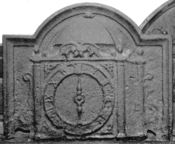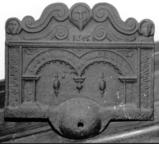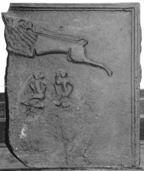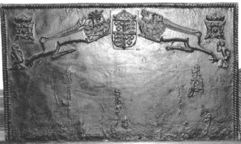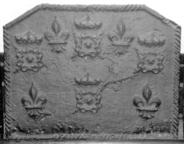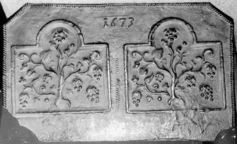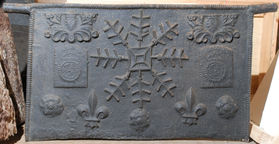-
118
Description: Rectangular with triangular pediment; stepped fillet and ogee moulded edge; initials in rectangular panel (F reversed); date in portico.
Notes: The triangular top is a separate element, in this instance impressed before the lower panel. A variant at the Victoria and Albert Museum (no. 771) has the letters positioned slightly differently. A version of this fireback, with a rope-edged panel in the lower part, and medallion stamps, can also be seen at Hastings. Formerly part of the Ade Collection (from Grove Hill, Hellingly, Sussex).
Inscription: 1586 F M
- Decoration tags:
- triangular arched (shape)
- stepped fillet and ogee (edging)
- individual letters
- date stamp
- text
Manufactured: in 1586 in the Weald area of England.
Current location: Hastings Museum and Art Gallery, John's Place, Bohemia Road, Hastings, East Sussex, England.
Museum number: HASMG: 1952.51.58 (part of the Hastings Museum museum group)
Citation: Lloyd, N., 1925, 'Domestic Ironwork I', Architectural Review, 58, pp. 58-67.
- Attached to series:
- 1586 series
- Date & initials firebacks
-
119
Description: Arched rectangular shape; cavetto moulded edge on all sides; perspective view of a lantern clock.
Notes: The arms of the Worshipful Company of Clockmakers were granted in 1672: Sable a Clock each of the four pillars of the case based on a Lion couchant and capped with a Globe surmounted by a Cross and on the dome of the case an Imperial Crown all Or. The hands of the clock show six o’clock, as on the livery company shield. Formerly part of the Ade Collection (from Grove Hill, Hellingly, Sussex).
Copies of this fireback are known.
- Decoration tags:
- rectangular with round arch (shape)
- cavetto (edging)
- whole carved pattern
- objects
Manufactured: in the mid-17th century in the Weald area of England.
Current location: Hastings Museum and Art Gallery, John's Place, Bohemia Road, Hastings, East Sussex, England.
Museum number: HASMG: 1952.51.48 (LA 776) (part of the Hastings Museum museum group)
- Attached to series:
- Small cavetto series
- Livery company firebacks
-
123
Description: Rectangular; top panel with bearded face between symmetrical horizontal scrolls, and faces at either end; scrolls are repeated below, on either side of the date, all above a horizontal double fillet; below, a pair of arches with guilloche decoration between fillets, and toothed on the underside, are supported on each side by Tuscan columns, also with guilloche decoration; this is repeated in symmetrical rectangular panels on either side; at the centre base a bulbous nozzle protrudes.
Notes: This is a smith's forge fireback, the nozzle being the tuyere directing the air into the fire from bellows behind. Stylistically similar to the Lenard and other firebacks of the same period, the carved elements above the nozzle may have been cast from a pattern inspired by the back of a joined 'wainscot' chair, with the date inserted. The back may have been used for forging non-ferrous metals as there was a trade in pot-founding in bronze as well as iron at some ironworks in the Weald. Formerly part of the Ade Collection (from Grove Hill, Hellingly, Sussex).
Inscription: 1655
- Decoration tags:
- rectangular with round arch (shape)
- fillet (edging)
- whole carved pattern
- individual numbers
- architectural
- text
- humans
Manufactured: in 1655 in the Weald area of England.
Current location: Hastings Museum and Art Gallery, John's Place, Bohemia Road, Hastings, East Sussex, England.
Museum number: HASMG: 1952.51.62 (part of the Hastings Museum museum group)
Citation: Butterfield, W. R., 1916, 'Old Wealden Firebacks', The Connoisseur, 46, pp. 197-209.
- Attached to series:
- Chair pattern firebacks
- Furniture stamp firebacks
-
124
Description: Canted rectangle; twisted rope edging (top and sides); top centre, crowned Tudor royal shield; fleur de lys on each side and below; slanting, inverted 'V' of twisted rope on each side of lower fleur.
Notes: One of a large series of firebacks incorporating Tudor heraldic stamps; the 'V' shapes may have apotropaic significance.
Arms: Tudor royal arms of England
- Decoration tags:
- rectangular with canted top corners (shape)
- rope (edging)
- simple stamps
- carved stamps
- heraldic
- apotropaic
- armorial
- objects
Manufactured: in the mid-16th century in the Weald area of England.
Current location: Hastings Museum and Art Gallery, John's Place, Bohemia Road, Hastings, East Sussex, England.
Museum number: HASMG: 1904.32 (part of the Hastings Museum museum group)
- Attached to series:
- Royal series
-
126
Description: Fragment; rectangular; astragal and fillet edging (top and sides); oblique lion passant above two left facing 'imps', one with right arm raised, the other with both arms lowered.
Notes: One of the legs of the leopard is missing, suggesting that the stamp, which appears complete on many firebacks, was well used and had been damaged; this suggests a relatively late use of this stamp.One of a large series all bearing royal heraldic stamps, but unusual in the use of moulded edging, twisted rope being normally used for this series. The surviving elements were probably mirrored on the missing half. Formerly part of the Ade Collection (from Grove Hill, Hellingly, Sussex).
- Decoration tags:
- rectangular (shape)
- astragal & fillet (edging)
- carved stamps
- heraldic
- animals
- humans
Manufactured: in the mid- to late-16th century in the Weald area of England.
Current location: Hastings Museum and Art Gallery, John's Place, Bohemia Road, Hastings, East Sussex, England.
Museum number: HASMG: 1952.51.12 (LA 760) (part of the Hastings Museum museum group)
- Attached to series:
- Royal series
-
127
Description: Rectangular; twisted rope edging (top and sides); top centre, crowned Tudor royal shield between a lion passant on the right and a lion passant guardant sinister on the left; in each top corner a crowned four-petal rose, below which, to the right, a left-facing 'imp' with right arm raised, and to the left, a left-facing 'imp' with both arms lowered.
Notes: One of a large series bearing heraldic stamps.
Arms: Tudor royal arms of England
- Decoration tags:
- rectangular (shape)
- rope (edging)
- carved stamps
- heraldic
- armorial
- animals
- humans
Manufactured: in the mid-16th century in the Weald area of England.
Current location: Hastings Museum and Art Gallery, John's Place, Bohemia Road, Hastings, East Sussex, England.
Museum number: HASMG: 1925.3 (part of the Hastings Museum museum group)
- Attached to series:
- Royal series
-
128
Description: Canted rectangle; twisted rope edging (top and sides), with dowel across the top corners; symmetrical arrangement of four crowned four-petal roses, top centre, bottom centre and both top corners; symmetrical arrangement of four fleurs de lys, two either side of top central rose, two in bottom corners.
Notes: One of a large series bearing heraldic stamps. Given to Hastings Museum by Mr A. E. Anderson of Brightling Hall, Robertsbridge, Sussex.
- Decoration tags:
- rectangular with canted top corners (shape)
- rope (edging)
- carved stamps
- heraldic
Manufactured: in the mid-16th century in the Weald area of England.
Current location: Hastings Museum and Art Gallery, John's Place, Bohemia Road, Hastings, East Sussex, England.
Museum number: HASMG: 1914.64.1 (part of the Hastings Museum museum group)
Citation: Butterfield, W. R., 16 Feb 1935, 'A Tudor Fireback', Hastings and St Leonards Observer.
Citation: Baines, J. M., 1958, Wealden Firebacks (Hastings Museum).
- Attached to series:
- Royal series
-
129
Description: Canted rectangle; twisted rope edging (top and sides); date stamp top centre; arched rectangular style fireback with cavetto-moulded edge and fructed ‘vine’ plant design, impressed twice; vertical twisted rope length between. Damage to bottom corners.
Notes: A composite fireback using the impressions of another fireback repeated for a symmetrical design. Formerly part of the Ade Collection (from Grove Hill, Hellingly, Sussex).
Inscription: 1673
- Decoration tags:
- rectangular with canted top corners (shape)
- rope (edging)
- composite
- date stamp
- text
- plants
- objects
Manufactured: in 1673 in the Weald area of England.
Current location: Hastings Museum and Art Gallery, John's Place, Bohemia Road, Hastings, East Sussex, England.
Museum number: HASMG: 1952.51.65 (part of the Hastings Museum museum group)
- Attached to series:
- Composite firebacks
- Small cavetto series
-
131
Description: Rectangular with lifting handles; twisted rope edging (top and sides); elaborate central rope design of concentric squares with eight symmetrical arms each with six branches; two crowned rose en soleil stamps left and right centre; three roses across the bottom interspersed with two fleurs de lys; in top corners, two carved furniture-derived stamps. The width of the main plate is 876mm.
Notes: The rose-en-soleil was the badge of King Edward IV and, thus, a Yorkist symbol. The individual stamps are to be seen, separately or together, on other firebacks, indicating a common source; lifting handles are infrequently encountered on firebacks. The elaborate central rope array may be an interpretation of the escarbuncle, which was the principal heraldic charge on the arms of the Duchy of Cleves (1515-57), possibly associating this fireback with the brief marriage of Henry VIII and Anne of Cleves. Formerly part of the Ade Collection (from Grove Hill, Hellingly, Sussex).
- Decoration tags:
- rectangular (shape)
- rope (edging)
- simple stamps
- carved stamps
- lifting handles
- heraldic
- architectural
- objects
Manufactured: in the mid- to late-16th century possibly at Pounsley Furnace, Framfield in the Weald area of England.
Current location: Hastings Museum and Art Gallery, John's Place, Bohemia Road, Hastings, East Sussex, England.
Museum number: HASMG: 1952.51.44 (part of the Hastings Museum museum group)
-
141
Description: Arched rectangular shape; ovolo moulded edging; central oval shield of the arms of Penkhurst with fillet edge; date arranged in four corners.
Notes: The arms of Penkhurst: Argent, a fess ermines between six mullets sable. Probably the arms of Ferdinando Penkhurst, of Buxted Park, Sussex, who died in 1708. Formerly part of the Ade Collection (from Grove Hill, Hellingly, Sussex).
Inscription: 1707
Arms: Penkhurst, of Mayfield
- Decoration tags:
- rectangular with round arch (shape)
- ovolo (edging)
- whole carved pattern
- individual numbers
- armorial
- text
Manufactured: in 1707 in the Weald area of England.
Current location: Hastings Museum and Art Gallery, John's Place, Bohemia Road, Hastings, East Sussex, England.
Museum number: HASMG: 1952.51.46 (part of the Hastings Museum museum group)
Citation: Dalton, A., 2002, 'The Penkhurst family of ironmasters', Wealden Iron, 2nd ser., 22, pp. 23-26.
Citation: Lloyd, N., 1925, 'Domestic Ironwork I', Architectural Review, 58, pp. 58-67.
- Attached to series:
- Personal armorial firebacks

